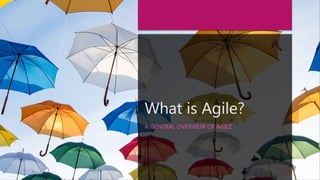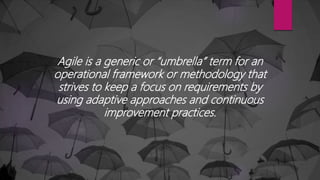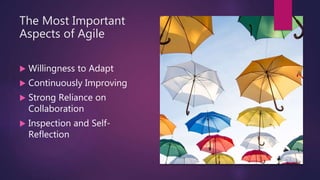What is agile?
- 1. What is Agile? A GENERAL OVERVIEW OF AGILE
- 2. Agile is a generic or “umbrella” term for an operational framework or methodology that strives to keep a focus on requirements by using adaptive approaches and continuous improvement practices.
- 3. Agile Tries to Focus the Organization On: Being More Flexible and More Responsive Making Sure the Work Product Meets Organizational Needs Closely Working with the Customer Throughout the Work Process Waiting Until the Last Responsible Moment to Finalize the Details Striving to be Better by Always Working to Improve Upon the Last Product Delivery
- 4. The Agile Umbrella Scrum Kanban Large Scale Scrum (LeSS) Disciplined Agile Delivery (DAD) Scaled Agile Framework (SAFe) Nexus Extreme Programming (XP) Dynamic Systems Development Methodology (DSDM) And Many, Many, More
- 5. Common Traits of Agile Approaches 1. Adapt to changing requirements 2. Continuously improve the work process and the product 3. Release work incrementally 4. Inspect with each incremental release 5. Focus on the product or work output as the primary measure of success 6. Gain frequent customer (primary user of the product or work output) input 7. Utilize servant-leadership philosophy 8. Allow for self-organizing teams
- 6. Not All Agile Approaches Will Have All of the Common Traits
- 7. The Most Important Aspects of Agile Willingness to Adapt Continuously Improving Strong Reliance on Collaboration Inspection and Self- Reflection
- 8. The Manifesto for Agile Software Development - 4 Values Individuals and interactions over processes and tools 01 Working software over comprehensive documentation 02 Customer collaboration over contract negotiation 03 Responding to change over following a plan 04
- 9. The 12 Principles Behind the Agile Manifesto Our highest priority is to satisfy the customer through early and continuous delivery of valuable software Welcome changing requirements, even late in development. Agile processes harness change for the customer's competitive advantage Deliver working software frequently, from a couple of weeks to a couple of months, with a preference to the shorter timescale Business people and developers must work together daily throughout the project Build projects around motivated individuals; give them the environment and support they need, and trust them to get the job done The most efficient and effective method of conveying information to and within a development team is face-to-face conversation
- 10. The 12 Principles Behind the Agile Manifesto - Continued Working software is the primary measure of progress Agile processes promote sustainable development; the sponsors, developers, and users should be able to maintain a constant pace indefinitely Continuous attention to technical excellence and good design enhances agility Simplicity--the art of maximizing the amount of work not done--is essential The best architectures, requirements, and designs emerge from self-organizing teams At regular intervals, the team reflects on how to become more effective, then tunes and adjusts its behavior accordingly
- 11. The 12 Principles of Agnostic Agile To put my customer first, making them independent To do my best, complementing theory with practical experience To tailor agility to context To understand hindering constraints and work to remove them To share, learn and improve To respect frameworks and their practitioners To acknowledge unknowns and seek help To never mislead and to never misrepresent To remember that agility is not the end goal To acknowledge that dogmatism is non-agile To recognize that there is more to agile than agile To give to the community as it has given to me
- 12. What is Agile? “Agile is the ability to create and respond to change. It is a way of dealing with, and ultimately succeeding in, an uncertain and turbulent environment.” https://www.agilealliance.org/agile101/
- 13. What is Agile Software Development? “Agile software development is an umbrella term for a set of frameworks and practices based on the values and principles expressed in the Manifesto for Agile Software Development and the 12 Principles behind it. When you approach software development in a particular manner, it's generally good to live by these values and principles and use them to help figure out the right things to do given your particular context.” https://www.agilealliance.org/agile101/
- 14. Differences in Agile Frameworks A lighter approach Scrum Kanban Extreme Programming (XP) Test-Driven Development (TDD) Feature-Driven Development (FDD) A complex and/or full lifecycle approach DSDM Scaled Agile (SAFe) Disciplined Agile Delivery (DAD)
- 15. Which Agile Approach Should You Use? Simple Environment A product development environment On-going backlog of features and improvements A more continuous flow of work A lighter approach Development Focused Complex Environment A project and program environment Multiple project dependencies Larger development team A full lifecycle approach Project/Program Focused
- 16. Agile Interesting Facts Agile did not begin with the Agile Manifesto (It just gained the name ‘Agile’) Many Agile frameworks can date back a decade or more before the word Agile was used to describe them Agile has a basis in Complexity Theory (Which in turn came from Systems Theory) Agile is not just for software projects, or even just for projects Scrum was intended as a Product Development framework Software projects are complex and new methods needed – thus Agile evolved there Something called Agile Manufacturing also exists Agile does not require iterations or sprints The removal of iterative and incremental development and focusing on the values of Agile is sometimes referred to as “Agility” Feedback loops in Agile are important; iterations developed to create that loop Kanban has no iterations, it is about a continuous flow Agile does not require daily standup meetings DSDM, Scrum, and other Agile Frameworks do require them
- 17. More Sources of Information https://agilemanifesto.org/ https://agnosticagile.org/ https://www.agilealliance.org/ https://agile-mercurial.com/2018/06/27/what-is-agile/ By Joshua Render What is Agile? https://agile-mercurial.com

















